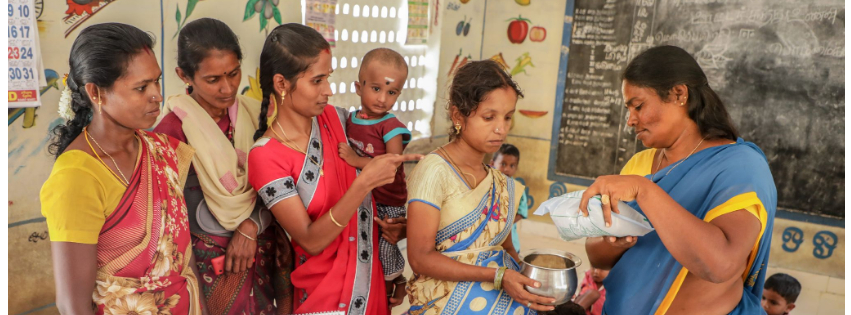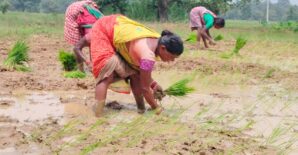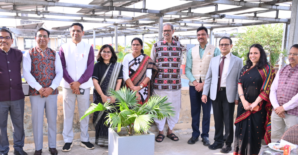BY SAPNA NAIR, RASMI AVULA, SATTVIKA ASHOK, KAVITHA RAMU
Provider, educator, surveyor, counsellor, consoler, friend – Sapna Nair and co-authors provide an inside look at the multiple roles that Tamil Nadu’s frontline health workers are playing during this critical time. We learn that these heroic women are adapting in different ways and technology has played a crucial role in ensuring continued, timely and quality health and nutrition services – Samuel Scott, series co-editor and Research Fellow, Poverty, Health, and Nutrition Division (PHND).

Before COVID-19 Pandemic beneficiaries are being given the take home ration. Made of wheat, jaggery, soya. Contains vitamins, minerals, folic acid, calcium, iron and protein. The THR is produced by the Women Development Cooperative Society of Chinnalapatty, Dindigul District. PC/ POSHAN
The World Health Organization declared the COVID-19 outbreak as a public health emergency of international concern on January 30, 2020, the day India reported its first case. As a policy response to contain the pandemic, India adopted the lockdown approach on March 24, with a few hours of lead time. To comply with social distancing, some health and social welfare services, including those delivered through the Integrated Child Development Services (ICDS) and the National Health Mission (NHM), were suspended or were required to be delivered using different modalities. Here, we present the case of the state of Tamil Nadu, where more than 48,000 Anganwadi workers (AWWs) and 11,000 Village Health Nurses (VHNs) deliver the essential health and nutrition services.
COVID-19 response in Tamil Nadu
Tamil Nadu, one of the high-income states in India, is considered a model state for human development and for positive maternal and child health and nutrition outcomes. Given its strong public health systems, it is potentially one of the states that could be better prepared in its pandemic response and quickly adapt to changes in service delivery requirements. On March 16, even before the nation-wide lockdown was announced, the ICDS department in the state directed closure of the ICDS centres, including guidelines on how to continue services under the new restrictions1. These guidelines were followed by multiple government orders to address the evolving needs arising during COVID-19.
Our conversations with six AWWs and five district officers revealed that distribution of food supplements and preschool education were continuing, although the ICDS centres were closed due to the lockdown. Reaching out to nearly 3.2 million beneficiaries with services is not easy. In lieu of the hot-cooked meals, AWWs and their helpers pack two-weeks’ worth of food supplements, including a reconstitutable nutrition powder called Sattumavu, as well as rice, pulses and eggs, and distribute them to homes with children, pregnant women, lactating mothers and out of school adolescent girls of 11-14 years.
AWWs are also using this opportunity to provide information on the importance of social distancing and handwashing. Routine growth monitoring is suspended and electronic real-time documentation by AWWs has been put on hold. Immunization services, particularly for pregnant women, are being provided once a month at the ICDS centres or at health sub-centres.
Creative use of smartphones for communicating with beneficiaries
With COVID-19, there have been some changes in the way AWWs are delivering the essential services. One of these changes include the evolved ways in which AWWs’ smartphones, received under India’s National Nutrition Mission for real-time monitoring, have been put to use. AWWs have created WhatsApp groups with beneficiaries, other AWWs and ICDS officials, and are sharing information through video and voice messages. For example, AWWs are sharing videos on using Sattumavu to create new recipes, ways of using household articles for learning, exercises, games, etc.
High smartphone use and the availability of these phones at home due to lockdown have ensured an expanded reach. According to the AWWs, they can reach out to around 40% rural beneficiaries and up to 80% urban beneficiaries through WhatsApp groups. The other beneficiaries are contacted through regular phone calls.
Virtual communication has not only helped to keep in touch with the children through video calls and phone conversations, but also facilitated expanding communication with other family members, particularly fathers and husbands in the family.
One AWW commented, “Now, husbands and fathers, in particular, are taking interest by watching the counseling videos that we share. This is very motivating for us to hear when women tell us how their family is more involved now’’.
The ICDS officials also opine that this mode has enhanced behaviour change communications. They remarked, “In fact, the regular activities, especially interaction with women and children, are happening better. Beneficiaries are providing feedback to AWW over phone. Interaction between parents, children and workers – a 3-way communication – is a big motivation factor for all.’’
Experiences of frontline workers as they shoulder additional responsibilities
during COVID-19
The AWWs have taken on additional COVID-19 containment responsibilities collaborating with health workforce in the state. At any given time, 10-50% of AWWs in each district are deputed for pandemic duty, usually lasting one to three weeks. The AWWs, along with the VHN, are conducting containment surveys to identify the spread, particularly in areas surrounding a positive COVID-19 case, quarantine surveys to detect symptoms and contact tracing, and community surveys to identify people with co-morbidities. During such visits, AWWs are providing information relevant to COVID-19 as well. Yet, there are anxieties that surface, as an AWW serving in a red zone1 said, “When we go to give dry ration, wearing gloves and masks, we can see people are tensed, suspecting they could be at risk, but they follow the advice and are cooperative’’.
Although AWWs are anxious about their safety, they are aware of the importance of their work and say that their families have been supportive. Another AWW serving in a red zone said, “… if we are advising people on safety, we must follow it within our homes first. My work is on field, where I have to meet people and I can’t avoid that, our families are aware of our duties and they are supportive. Being of help to the society is the need of the day’’.
The AWWs also speak of the anxieties their communities face and how they are dealing with it. Many children and mothers have anxieties related to the pandemic and are stressed about being cooped up in their homes. AWWs counsel them and recommend physical exercises and games that can engage them with their children in the limited physical space available. “When parents share pictures and videos of their kids engaging in the activities suggested by us or eating their meals, we feel our efforts are not going to waste’’, remarked an AWW from the town of Trichy.
There are concerns about pregnant women who are either nearing term or are at high risk. One AWW from Trichy reports speaking to them to allay their fears. The pandemic-induced emergency has facilitated closer coordination across and within departments, transcending the hierarchies. The ICDS officials at districts are personally following-up with some of the high-risk pregnant women, regarding their nutrition and risk symptoms. Given that there is no public transport available, the AWWs connect households with pregnant women to ambulance numbers or in some cases, access to other department vehicles for transport.
While the AWWs have been able to leverage technology and their long-standing relationships in ensuring the continuation of critical services, they have been able to leverage their established trust to fulfil their COVID-specific duties. These women either belong to the same village or are easy to spot in their uniforms, often chatting with women in the locality and seen as a friend and go-to counsellor. These social connections, knowledge of community contexts, and commitment have made these last-mile workers formidable foot soldiers. As COVID-19 persists, the many roles of AWWs need to be recognized and supported. In addition to their existing role, they now provide services and information, allay fears and anxieties, and assist in disease surveillance.
Essential health and nutrition services cannot take a backseat: Continuous learning on what works is needed
Tamil Nadu’s experience, thus far, indicates that the system is adaptable at multiple levels, and such adaptations in response to the pandemic have insights for other states. The current dynamic policy response to COVID-19 and efforts to preserve the core maternal and child health services will benefit from learnings from the ground. It is timely to build a learning agenda that systematically documents positive adaptations to service delivery. Such an effort will help identify feasible solutions that have the potential to strengthen the delivery of services through the pandemic and beyond.
Sapna Nair is Research Fellow and heads health research at LEAD at Krea University. Rasmi Avula is Research Fellow at IFPRI. Sattvika Ashok is a Research Analyst at IFPRI. Kavitha Ramu, IAS, is Director, ICDS in Tamil Nadu. Inputs from Joint Directors of ICDS are acknowledged. The analysis and opinions expressed in this piece are solely those of the author.
This blog has been published as a part of the International Food Policy Research Institute (IFPRI), South Asia, blog series on analyzing the impacts of the COVID-19’s pandemic on the sub-national, national, and regional food and nutrition security, poverty, and development. To read the complete blog series click here
1 Integrated Child Development Service. March 16, 2020. Circular (No.2879/2020) to ICDS Officials on closure of Anganwadi Centres as per directive from State Government. Tamil Nadu
2 Defined by Ministry of Health and Family Welfare as high incidence districts, based on incidence rates of COVID. Details in https://static.mygov.in/rest/s3fs-public/mygov_15883406691.pdf
New research from a Special Issue of Applied Economic Perspectives and Policy
The pandemic caused disruptions to both the supply of and demand for health services that persisted past the lifting of lockdown measures.
Public food transfer programs have traditionally been the most common social protection programs in Bangladesh



